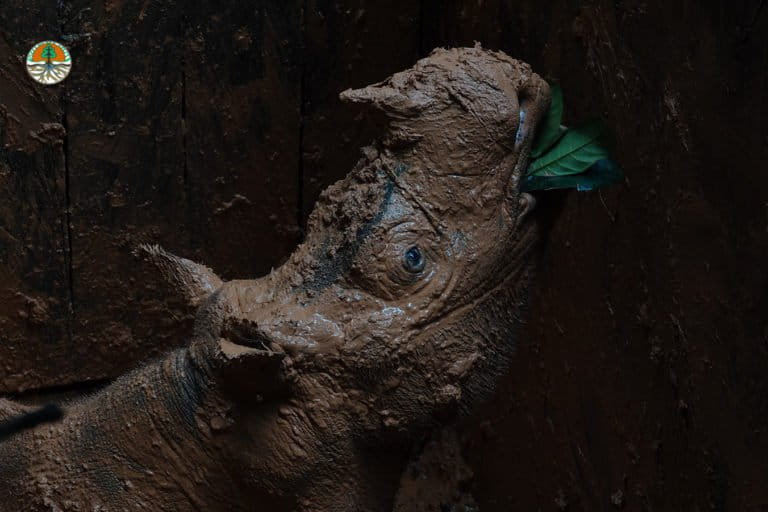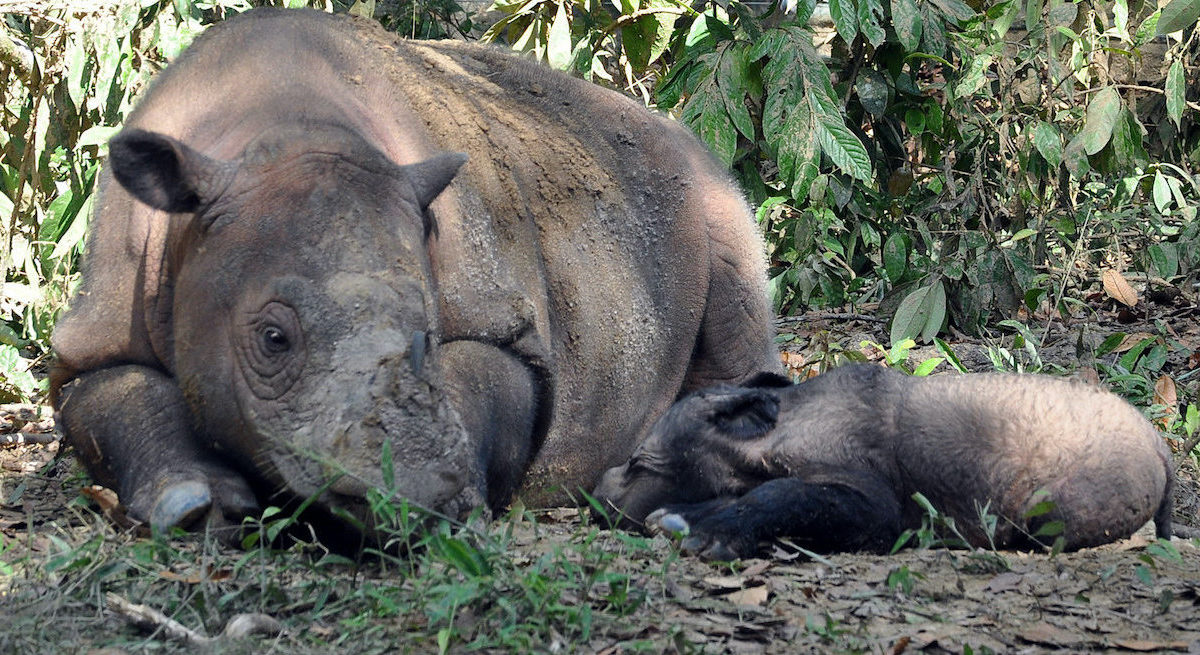- September 22 marks World Rhino Day, which looks to bring attention to the protection of the two African and three Asian rhino species that exist today.
- Of these five species, the Sumatran rhino is in the greatest peril, described as the most endangered large mammal on Earth.
- Its population is estimated at fewer than 80 individuals living in small, isolated habitats in Indonesia, where a low birth rate (a result of their isolation due to habitat fragmentation) is now the biggest threat to their survival.
- Rhino experts have called on the Indonesian government to do “real work” to save the species, including on a captive-breeding program widely seen as the last feasible means of staving off extinction.
JAKARTA — On World Rhino Day, conservationists are calling on the Indonesian government to do “real work” to save the Sumatran rhino, a species described as the most endangered large mammal on Earth.
Celebrated every Sept. 22 since 2010, World Rhino Day calls for the global community to help protect the two African and three Asian species of rhinoceros from extinction: the white rhino (Ceratotherium simum), black rhino (Diceros bicornis), greater one-horned rhino (Rhinoceros unicornis), Javan rhino (Rhinoceros sondaicus), and Sumatran rhino (Dicerorhinus sumatrensis). While each species faces perils ranging from poaching to low-birth rate to habitat loss, the Sumatran rhino is deemed to be the most at threat, its population having declined by more than 70% in the past 30 years.
This year, in particular, the global coronavirus outbreak has posed new challenges for rhino experts from around the world and in Indonesia, home to the last remaining Sumatran rhinos after the death of the last individual in Malaysia in late 2019.
“At the end of the day, human intervention through partnerships with all stakeholders will be key to protecting the Sumatran rhino population from extinction,” Inov Sectionov, Indonesia program coordinator at the International Rhino Foundation (IRF), told Mongabay in an email.

Fewer than 80 Sumatran rhinos are believed to remain in small, isolated populations on Sumatra and in Indonesian Borneo, also known as Kalimantan. That includes seven individuals at a captive-breeding center in Way Kambas National Park in Sumatra, and a single captive female at the Kelian sanctuary in Borneo’s East Kalimantan province. The species’ population was historically decimated by poaching and habitat loss, but the main threat today is the low birth rate as a result of habitat fragmentation, which means individual males and females in the wild are less likely to encounter each other.
In 2017, the Indonesian government developed an emergency action plan for Sumatran rhinos, which includes increasing protection of rhino habitats, surveying the remaining wild population, and capturing those individuals with reproductive potential and moving them to captive-breeding and research facilities such as those at Way Kambas and Kelian.

According to Inov, the action plan, which calls for the help of international conservation groups, was meant to come up with an overview of the state of Sumatran rhinos by the end of this year. But longstanding challenges on the ground, exacerbated by movement restrictions imposed in response to the COVID-19 pandemic, have delayed those efforts. Inov said the IRF had been scheduled this past June to hold a global training seminar on how to rescue wild Sumatran rhinos in Indonesia, but the plan was postponed until next year.
Measures to slow the spread of COVID-19 have delayed other key conservation plans, including the development of a new sanctuary in northern Sumatra, and the capture of a wild female rhino in East Kalimantan. A decision by Indonesia’s environment ministry to abruptly cut ties with WWF Indonesia also affected the latter program; WWF had been instrumental in capturing the sole female now at the Kelian sanctuary.
There have been no reported cases of coronavirus transmission from humans to rhinos, as has been reported among other species, such as felines and primates. Nevertheless, the keepers at the two Sumatran rhino sanctuaries have implemented strict health and safety protocols for the individuals in their care, according to the IRF.
“COVID-19 has presented hurdles with delays in planned training and rescue options for this year,” Nina Fascione, the IRF’s executive director, said in a statement. “Timing is critical and we all must do what is possible to save the Sumatran rhino from extinction.”
While indications of active Sumatran rhino poaching are scarce, Inov said threats to their habitats are still mounting, to the extent that there needs to be “real work” done by the authorities and conservationists, moving beyond rhetoric that’s “merely stated in pages of strategy and discussion.”
“I feel it’s very ironic that an endangered species like the Sumatran rhino that’s currently only existing in Indonesia and important to the environment, could vanish from the face of the Earth just because we are late to rescue it,” Inov said.

FEEDBACK: Use this form to send a message to the author of this post. If you want to post a public comment, you can do that at the bottom of the page.
